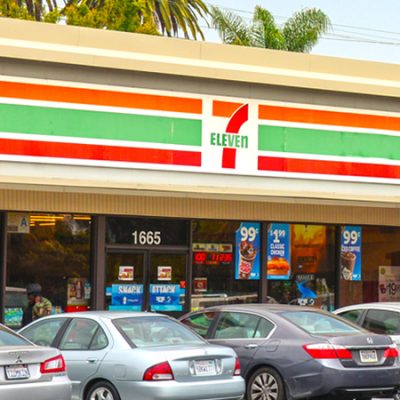Single-tenant retail activity is heating up. This year, the single-tenant retail market has been active, with several transactions breaking cap rate records. Jeremy McChesney, EVP of Hanley Investment Group Real Estate Advisors, recently closed three deals for single-tenant and two-tenant 7-Eleven properties in Los Angeles, San Diego and Bakersfield. In Los Angeles, the deal broke the record for the lowest recorded closing cap rate for a multi-tenant retail property. We sat down with McChesney for an exclusive interview to find out how investors are responding to the record-low cap rate environment. He says that in Southern California these retail properties are commodities, and investors know that they have to pay to play in the market. Here, he tells all about the trend for single-tenant retail.
GlobeSt.com: What are the pricing and cap rate trends for single-tenant retail properties in Los Angeles? How about two-tenant retail properties, like the one you sold in L.A.?
Jeremy McChesney: The most sought-after retail asset is a single-tenant asset with a high-credit rating, a long-term lease and in a desirable location. In Los Angeles, the demand for this type of high-quality asset remains very strong, especially for new construction. Investors will typically pay more for a single-tenant asset than they will for a multi-tenant property, depending on whether the two or more tenants are creditworthy. Potentially, with a two-tenant property, there can be some type of management that’s required. For example, you have to divide up how the water and electricity are handled between the two tenants as well as the maintenance of the common area.
At the end of the day, it is still location, location, location. The 7-Eleven /Launderland property was located at the signalized corner of Robertson Boulevard and Airdrome Road with daily car counts exceeding 57,000 cars per day. Within the one-mile trade area, there are more than 43,000 residences with an average household income of $98,000. Both 7-Eleven and the laundromat had a 40-year operating history at this site on Robertson Boulevard and had recently signed a 10-year lease extension, which spoke to the strength and performance of this location. The property closed at a cap rate of 4.03 percent, 100 percent of the list price, and $931 price per square foot. According to CoStar, this sale represents the lowest recorded closing cap rate in the nation for a multi-tenant 7-Eleven property in 2017. Many of the interested parties that were looking to purchase the property grew up in this neighborhood where 7-Eleven was located. Some of them would go to this same 7-Eleven to play video games or buy candy there. What was interesting about marketing this retail property is that I had never in my career had so many offers from buyers that were located in the immediate vicinity of a property. They all knew the property well having been a customer of that 7-Eleven. But at the end of the day, it was the buyer with the highest purchase price that closed the deal.
GlobeSt.com: How does this compare to surrounding Southern California markets, like Orange County and San Diego?
McChesney: Like Los Angeles, it really boils down to the location of the asset, the quality of the tenant and the lease terms. Generally speaking, Orange County and San Diego, like Los Angeles, are very strong markets right now. Coastal areas are going to outperform inland Southern California markets like Riverside and San Bernardino counties where household incomes are less. Many investors prefer to own close to home.
GlobeSt.com: How are investors responding to such low—and getting lower—cap rates?
McChesney: I don’t think cap rates are getting any lower than they already are. I call it a “pay to play” environment that we live in Southern California. If you want Southern California real estate, you have to pay a premium for it. That means that the cap rates are going to be lower. You could take the exact same retail asset with the same tenancy and lease terms, etc. and move it outside of California to a similar metro area in Texas or Colorado, and you will get a significantly better return. This is nothing new. It has always been like this and I don’t anticipate it changing.
GlobeSt.com: What is your outlook for this retail niche in 2018?
McChesney: As long as interest rates stay where they are, and there are no unforeseen impacts to the economy, we expect that sales volumes for high-quality single-tenant net leased investments to stay strong in 2018. High quality, single-tenant retail assets are nearly a “commodity.” They are easy to own and relatively easy to sell since they are in such high demand. The location of such tenants as single-tenant national chains like 7-Elevens or Walgreens typically have good real estate fundamentals including high-profile corner locations, great proximity and ease of access to major thoroughfares along with strong demographics. Furthermore, a majority of these properties have corporate-backed absolute triple-net leases. Single-tenant net-leased convenience stores are particularly well positioned against the encroaching Amazon wave. Keen investors are looking for “Internet resistant” retailers, and the convenience store chains, along with fast food and auto parts stores are a good hedge against this growing invasion.
7-Eleven has a credit rating of AA-. Auto parts stores such as AutoZone, O’Reilly Auto Parts and Advanced Auto Parts have a BBB credit rating and have strong financials as well, in addition to having long-term leases with replaceable rent, if needed. Another unique facet to both 7-Eleven and auto parts stores is they are incredibly resistant to downturns in the economy. McChesney currently has multiple 7-Eleven properties available for sale including single-tenant 7-Elevens in Missouri, New York, Ohio and Florida.

